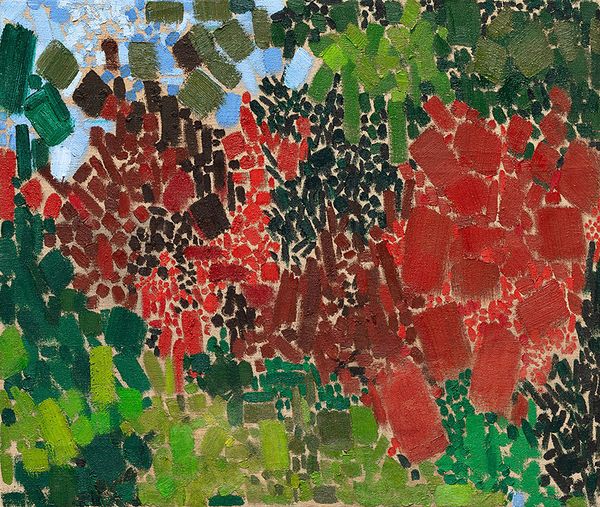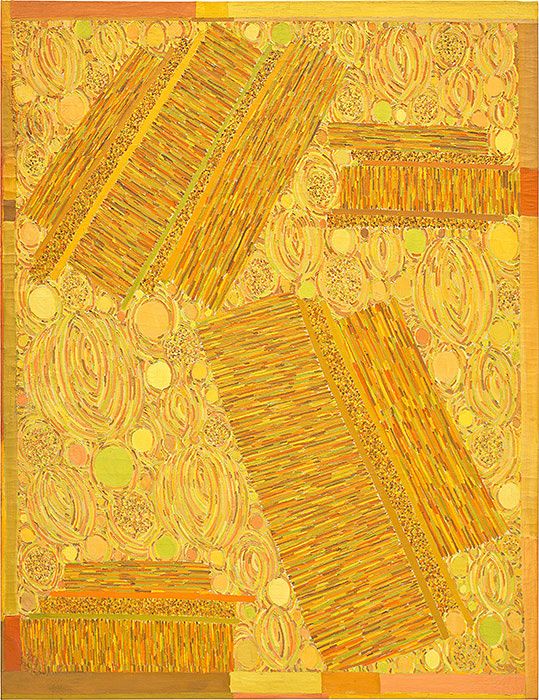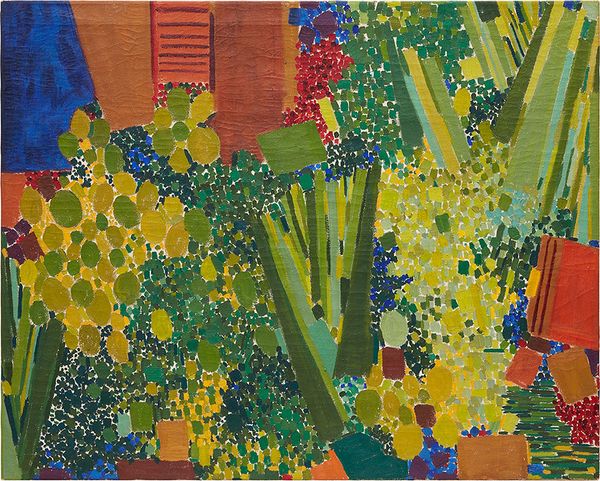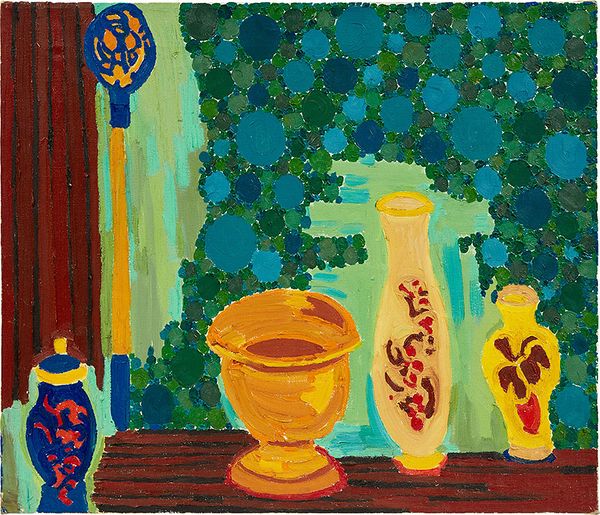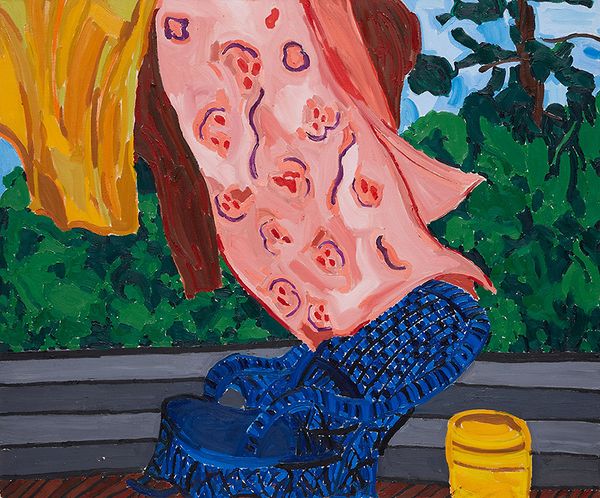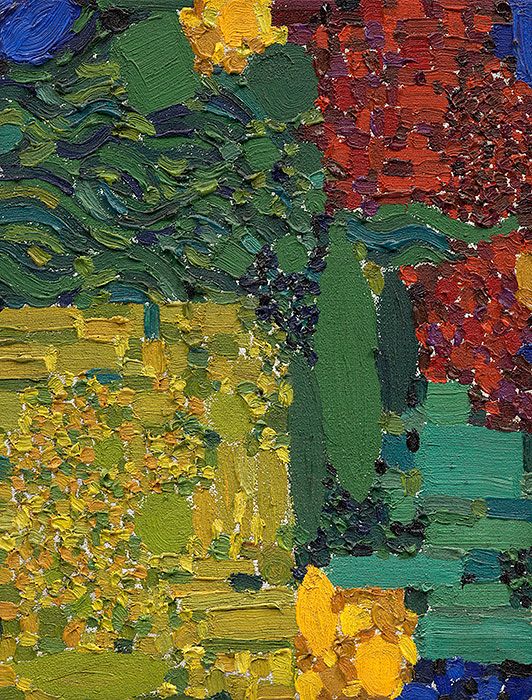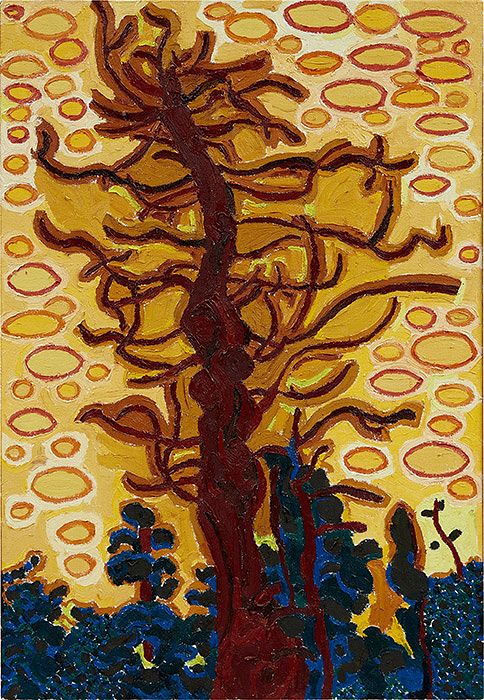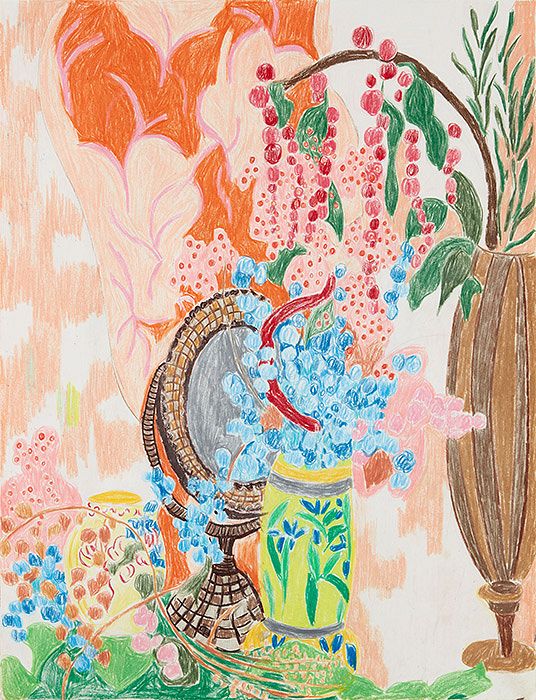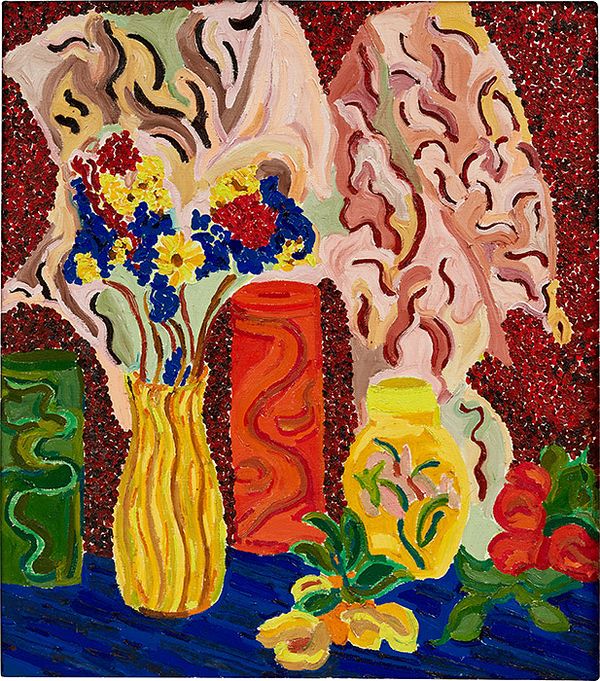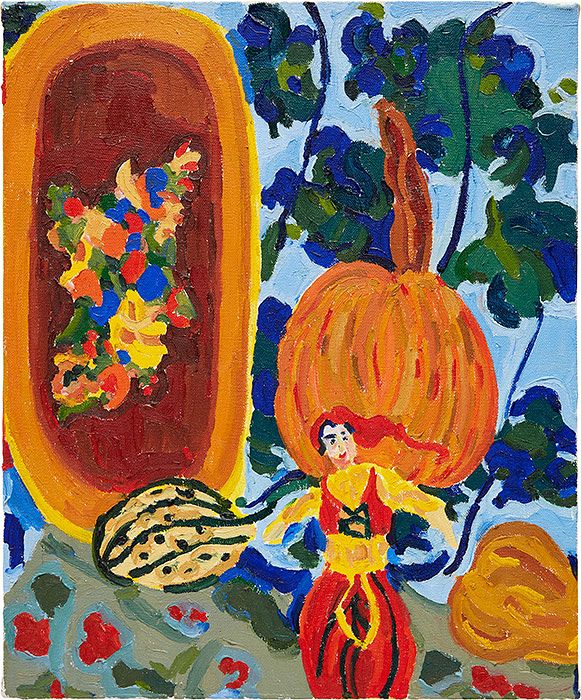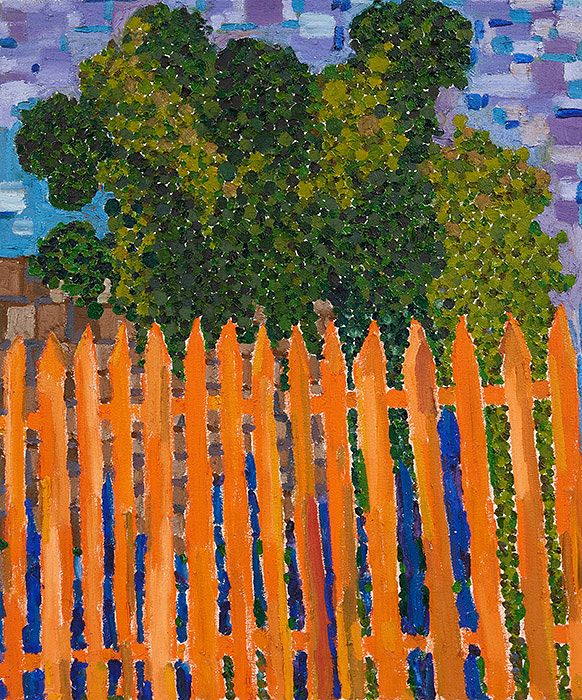Lynne Drexler, Untitled, 1962, oil on canvas, 17 3/4 x 21 1/8 in. (45.1 x 53.7 cm). Lynne Drexler’s Garden: Works from the 1950s–1990s.
For our first PhillipsX selling exhibition in this year’s Summer on Park series in New York, the galleries at Phillips are abloom with the vivid color and vitality of Lynne Drexler’s Garden: Works from the 1950s–1990s. View the works here.
Lynne Drexler (1928–1999) is a second-generation Abstract Expressionist painter who has risen to wide acclaim only in the last several years. We showcase a curated selection of 31 of her paintings and color pencil drawings to chart her astonishing stylistic progression over five decades.
What comes into focus is a love story between an important woman artist long overlooked by history — like too many in every generation — and a remote island where she rediscovered herself as a painter through the successive chapters of her career.
Interest in the women of Abstract Expressionism such as Lee Krasner, Helen Frankenthaler, and Joan Mitchell has been growing for some time. Now, one hopes that Drexler is also on her way to being enshrined in the canon.
Exhibition viewing: 25 July – 11 August, 2024
Location: 432 Park Avenue, New York, NY, 10022
LYNNE DREXLER'S UNIQUE STYLE
Lynne Drexler, Impacted Sun, ca. 1960s–70s, oil on canvas, 67 x 49 in. (170.2 x 124.5 cm). Lynne Drexler’s Garden: Works from the 1950s–1990s.
A Remarkable Trajectory from Abstract to Representation
Drexler enjoyed a promising beginning as an abstract painter of the New York School in the late 1950s. Early on, she innovated a non-objective style of delivering color in small floating rectangular tabs of paint resembling mosaic tiles. These patches come together in her work like musical notes in contrapuntal arrangements of textured fields and clusters, painstakingly orchestrated to create vibrational harmonies and dynamic tensions of pure color.
Her early works recall the mystical intensity of Vincent Van Gogh, Pointillism’s rich opticality, and the floating bubbles of color we see in Gustav Klimt. A lover of classical music, Drexler regularly drew for inspiration during live performances at the Metropolitan Opera and Carnegie Hall. Initially, her application of paint was slow and methodical, often differentiated in the size and shape of her stroke for each color, so that as they take on independent personalities of their own, as though being played by different musical instruments.
Lynne Drexler, Green Bursts Upon Desert, 1963, oil on canvas, 30 x 40 in. (76.2 x 101.6 cm). Lynne Drexler’s Garden: Works from the 1950s–1990s.
After nearly a decade of struggling to break through with her purely non-objective style, however, the artist turned a blind eye to the fickle trends of the New York gallery world and embarked on a long, slow, and fruitful creative journey from abstraction to representation.
There are no abrupt jumps in her style. One sees instead a thoughtful, continuous, and steady progression over time. At first, it’s only glimpses of natural elements mixed in among her abstract patterned fields. Later, as the recognizable forms of flowers and trees begin to appear, her brush becomes less systematic and more fluid and responsive to the character of her subject. Curvilinear elements arise, then entire melodies.
Lynne Drexler, Press, 1969, oil on canvas, 12 x 8 3/4 in. (30.5 x 22.2 cm). Lynne Drexler’s Garden: Works from the 1950s–1990s.
In 1967, Minimalism was dominating the city’s commercial gallery scene. Alienated by the movement’s cold cerebral geometry, she deepens her allegiance to the more organic rhythms of the natural world, evolving her optical pictorial fields into sensuous impasto renderings of dense organic forms in a quasi-landscape space.
By the 1980s, Drexler’s paintings and drawings come to life as fully fleshed out naturalistic landscapes and still lifes bursting with vibrant color. Nature was always there in the back of her mind, Drexler claimed — “I've not changed styles so much as I have added and subtracted.” But her works take flight in a profusion of leaves and blossoms as never before.
Lynne Drexler, Vase Formality, 1981, oil on canvas, 18 x 21 in. (45.7 x 53.3 cm). Lynne Drexler’s Garden: Works from the 1950s–1990s.
We see in the mature Monhegan Island paintings of her last decades the breezy, natural ease of the master, as she adapts the sophisticated pictorial language she developed in her earlier non-objective works to respond spontaneously and without pretense to the immediacy of the beauty that surrounded her in the smallest of everyday things.
Lynne Drexler, Gusty Day, 1982, oil on canvas, 30 x 36 in. (76.2 x 91.4 cm). Lynne Drexler’s Garden: Works from the 1950s–1990s.
She finally achieved that unique stylistic synthesis of Abstract Expressionism and Post Impressionism for which her later works are prized. In these, the inspiration of Henri Matisse comes to the fore in the exuberant playfulness and inventiveness of her color and composition.
DREXLER'S EARLY YEARS IN NEW YORK
Studies with Hofmann and Motherwell
Back in 1956, after painting classes at the College of William and Mary, Drexler received a scholarship to Hans Hofmann’s summer program in Provincetown. She continued at his school in New York — as Krasner and Frankenthaler had before her. Hofmann taught her to think through a painting like an Abstract Expressionist — and she would continue to draw on his “push-pull” theories of color and composition throughout her career to create dynamic pictorial space with striking combinations of warm and cool hues optically advancing and receding against the flatness of the picture plane.
She subsequently pursued her MFA at Hunter College under the tutelage of Robert Motherwell, among the most influential of all the Abstract Expressionist painters, who personally coined the term “New York School.” From him she learned the rigorous discipline of thinking through ideas from one painting to the next, which was to lay the foundation for her artistic evolution through the years. Motherwell believed in her talent. When she confessed to him that she wanted the degree to become a teacher, he reportedly replied, “I’ll flunk you out of here before I see you go to teach. You’re too good a painter.”
Her New York Debut
Drexler had been among the downtown Abstract Expressionist painters who gathered at the Cedar Tavern and the Artists’ Club for heated discussions about art. Her first one-person exhibition in 1961 at Tanager Gallery, an artist-run space downtown on Tenth Street next door to de Kooning’s studio, signaled her arrival on the scene. To her great surprise, nothing sold and her groundbreaking new style went largely unnoticed. Many of the more successful Abstract Expressionist painters were already showing at established commercial galleries uptown. She was too new. Nor did it help that she was a woman.
Lynne Drexler, Formal, 1968, oil on linen, 9 1/4 x 8 1/8 in. (23.5 x 20.6 cm). Lynne Drexler’s Garden: Works from the 1950s–1990s.
DREXLER IN MONHEGAN, MAINE
Her Island Muse
Gaugin had his Tahiti. For Monet, it was Giverny. Lynne Drexler’s muse was Monhegan Island off the coast of Maine — a remote and unmanicured speck of land for fisherman and tourists, an hour by ferryboat from the mainland, where nature ran wild.
Lynne Drexler, Tree Skeletal, 1992, oil on canvas, 26 x 16 in. (66 x 40.6 cm). Lynne Drexler’s Garden: Works from the 1950s–1990s.
The spirit of this place — not to mention its rugged natural beauty — powerfully infuses Drexler’s oeuvre. When we see hints of trees and other natural forms in her work — even from before she started working directly from life — we’re seeing the influence of Monhegan Island on her psyche. “I don’t come or go from the island unless the sea cooperates,” she once said, “[It] makes me very much aware of a higher power controlling a given individual and intensifies my own sense of spirituality.”
It was the painter John Hultberg who first introduced Drexler to Monhegan Island, after the two married in 1962. Six years her senior and already a rising star, he was represented by legendary gallerist Martha Jackson, who had bought him a house there to paint, away from the hectic distractions of the city. Drexler took to it immediately — and thereafter, every year, they always returned to summer on Monhegan Island and paint.
Lynne Drexler, Naked Sentinels, 1980, oil on canvas, 20 x 24 in. (50.8 x 61 cm). Lynne Drexler’s Garden: Works from the 1950s–1990s.
In 1983, the couple finally made the Monhegan Island house their year-round residence. Within a year, however, he moved away to Portland — and then back to New York for good. She was on her own.
Lynne Drexler, Untitled, ca. 1980s, colored pencil and crayon on paper, 23 1/2 x 18 in. (60 x 45.7 cm). Lynne Drexler’s Garden: Works from the 1950s–1990s.
Drexler's Garden in Full Floom
Drexler had long cherished her seclusion and obscurity as a shield against the strong opinions of New York critics and dealers. Welcoming the end of her marriage as an opportunity to immerse herself completely in a world all her own, she gave free reign to her intuition as never before — filtering her ideas about color and composition through the mystical prism of her daily life to create the most personal and intimate works of her career. She knew she was good. She no longer needed to prove it to anyone.
Lynne Drexler, Objects of Cheer, 1988, oil on canvas, 25 x 22 in (63.50 x 55.88 cm). Lynne Drexler’s Garden: Works from the 1950s–1990s.
For the duration of her last two decades, Drexler came to deeply appreciate the simplicity of her daily routines of uninterrupted painting during the daylight hours, drawing at the kitchen table, gardening, quiet walks, even daily chores like hanging the laundry. In the evenings, she socialized with neighbors. She loved a good laugh, it is said. On Sundays, she would invite friends over to listen to opera on the radio. By all accounts, she’d abandoned all hope of success, but she had stopped caring.
Lynne Drexler, Gypsy Agenda, 1989, oil on canvas, 17 x 14 in. (43.2 x 35.6 cm). Lynne Drexler’s Garden: Works from the 1950s–1990s.
Of an exhibit she was having in Queens, she wrote one friend, “To me it’s simply another show. Certainly I’ve no expectations of critical acclaim or sales.” To Hultberg, with whom she still occasionally corresponded, she was even more prophetic: “At present, we’re not wanted. Only glitz and outrage. But our day will come, even if we’re no longer here.”
Somehow, she knew. And, one hopes, she couldn’t be happier.
Lynne Drexler, Fenced Tree, 1997, oil on canvas, 24 x 20 in. (61 x 50.8 cm). Lynne Drexler’s Garden: Works from the 1950s–1990s.
EPILOGUE
Posthumous Triumph
After Drexler’s passing in 1999, the Monhegan Historical and Cultural Museum Association organized the first retrospective exhibition of her work in 2008. It travelled to the Portland Museum of Art in 2008 and 2009. The Lynne Drexler Archive came to be represented in the U.S. by Berry Campbell Gallery, which partnered with Mnuchin Gallery in 2022 to present the first solo show of her work in New York in more than three decades. Now, White Cube Gallery in London is representing her outside the U.S. and interest only continues to snowball.
